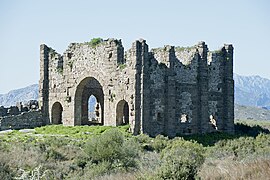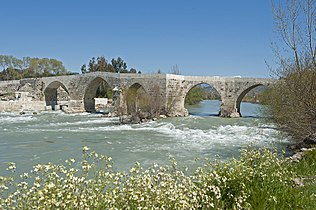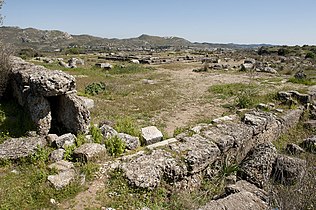Aspendos
Ἄσπενδος (in Ancient Greek) | |
 The Roman Basilica at Aspendos, 2011 | |
| Alternative name | Aspendus |
|---|---|
| Location | Serik, Antalya Province, Turkey |
| Region | Pamphylia |
| Coordinates | 36°56′20″N 31°10′20″E / 36.93889°N 31.17222°E |
| Type | Settlement |
Aspendos or Aspendus (
.It was situated on the
History

The wide range of its coinage throughout the ancient world indicates that, in the 5th century BC, Aspendos had become the most important city in Pamphylia. At that time, according to Thucydides, the Eurymedon River was navigable as far as Aspendos,[2] and the city derived great wealth from a trade in salt, oil and wool.
Aspendos did not play an important role in antiquity as a political force. Its political history during the colonisation period corresponded to the currents of the
Circa 465 BC, Cimon led an Athenian navy against a Persian navy in the Battle of the Eurymedon, and destroyed it. Aspendos then became a member of the Delian League.[3]
The Persians captured the city again in 411 BC and used it as a base. In 389 BC,

When
In 190 BC, the city surrendered to the
Greek and Roman structures

Aspendos is known for having the best-preserved theatre of antiquity, the Roman Theatre of Aspendos.[7] With a diameter of 96 metres (315 ft), it provided seating for 7,000.[8] Even though, the recent Aspendus Culture and Film Festival has shown that it can hold over 20,000.[9]
It was built in 155 As was usual to minimise construction complexity and cost, part of the theatre was built against the hill where the Citadel (Acropolis) stood, while the remainder was built on vaulted arches. The high stage, whose supporting columns are still in place,[2] served to seemingly isolate the audience from the rest of the world. The scaenae frons, or backdrop, has remained intact. The 8.1 metre (27 ft) sloping reflective wooden ceiling over the stage has been lost over time. Post holes for 58 masts are found in the upper level of the theatre. These masts supported a velarium or awning that could be pulled over the audience to provide shade.[8] The diameter of the orchestra is 23.87 meters and the height of the columnatio (stage backdrop) was 15.7 meters.[11]
The unique 19 km-long 
Nearby stand the remains of a stadium, baths, basilica, agora and nymphaeum. The Roman Eurymedon Bridge, reconstructed in the 13th century, is also in the vicinity.
Coinage

Aspendos was one of the earliest cities to mint coins. It began issuing coinage around 500 BC, first staters and later drachmas; "the slinger on the obverse represents the soldiery for which Aspendus was famous in antiquity,"[13] the reverse frequently depicts a triskelion. The legend appears on early coins as the abbreviation ΕΣ or ΕΣΤϜΕ; later coinage has ΕΣΤϜΕΔΙΙΥΣ, the adjective from the city's local (Pamphylian) name Estwedus. The city's numismatic history extends from archaic Greek to late Roman times.[14]
Bishopric
The Christian
No longer a residential bishopric, Aspendus is today listed by the Catholic Church as a titular see.[17]
Aspendos International Opera and Ballet Festival
The theatre hosts the annual Aspendos International Opera and Ballet Festival organized by Turkish State Opera and Ballet since 1994, with international participation of opera and ballet companies and an audience of about 10,000.
Dalida held her last concert there on 28 April 1987.
Gallery
-
Aspendos Agora and Market Hall
-
The Ornamental Gate
-
Roman aqueduct of Aspendos
-
The Basilica
-
The Eurymedon Bridge
-
The Nymphaeum
-
Aspendos Temple
References
- ISBN 90-04-12578-7), p. 189.
- ^ a b c d Hogarth, David George (1911). . In Chisholm, Hugh (ed.). Encyclopædia Britannica. Vol. 2 (11th ed.). Cambridge University Press. pp. 766–767.
- ^ Holidays to Turkey info Archived 2012-01-11 at the Wayback Machine
- ^ Cicero. In Verrem II. pp. 1. Chapter 53.
- ^ Diogenes Laertius, Lives of the Philosophers, § 5.83
- ^ Diogenes Laertius, Lives of the Philosophers, § 6.13
- ISBN 0-8109-0626-0.
The Roman theater survives virtually intact... scarcely another surviving theater gives a better impression of just how the Roman theater - a solid single unified structure - differed from the Greek theater, which was made up of separate structures juxtaposed but each isolated and complete in itself.
- ^ ISBN 0-06-430158-3.
- ^ Whitman College. "The Roman Theatre at Aspendus". Retrieved 2024-01-19.
- ^ Scott Redford, "The Seljuqs of Rum and the Antique," Muqarnas, Vol. 10, Essays in Honor of Oleg Grabar. (1993), p. 151.
- ^ Sear, Frank. Roman Theatres: An Architectural Study. p. 35.
- ^ Kessener, H. P. M. (2000). The aqueduct at Aspendos and its inverted Siphon. American Journal of Archaeology 13, 105 - 132
- ^ A Catalogue of the Greek Coins in the British Museum (British Museum. Dept. of Coins and Medals, 1897), p. lxxii.
- ^ "Asia Minor Coins – Greek and Roman coins of Aspendos". Archived from the original on 2011-01-04. Retrieved 2008-10-02.
- ^ Michel Lequien, Oriens christianus in quatuor Patriarchatus digestus, Paris 1740, Vol. I, coll. 1001–1002
- ^ Pius Bonifacius Gams, Series episcoporum Ecclesiae Catholicae, Leipzig 1931, p. 450
- ISBN 978-88-209-9070-1), p. 840
External links
- History of Aspendos
- Aspendos photos folder
- Maps of Aspendos
- How to go to Aspendos
- Plan of the Aspendos Antic Theater
- The Theatre at Aspendos, The Ancient Theatre Archive, Theatre specifications and virtual reality tour of theatre
- Livius.org: Aspendus
- Aspendos html5/full screen panoramas taken December, 2012
- Over 350 pictures from several visits
- Aspendos Archaeological Project 2008 –
- Top Ten Best Historical Places in Turkey including Aspendos checkout more detail








